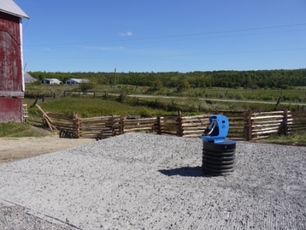Green Bay Creek

The Green Bay Creek site required two (2) Frostfree nose pumps to be installed to promote remote watering, and fencing was installed to restrict the livestock access to the creek. The pumps were installed on both sides of the barn due to the fact that the landowner required two separate yards for separating herds of cattle. The pumps were installed away from the creek to prevent contamination of the water source. The design of the pump prevents backwash, and the details of the system included a cement pad which prevents ground water contamination. The Green Bay Creek site required 46 meters of cedar rail fencing to restrict livestock access to the creek. Trees and shrubs were planted with the help of volunteers to vegetate the newly established riparian and canopy zone on both sides of the creek.
Benefits of frost-free nose-pumps:
The following accomplishments were completed:
This project had 7 volunteers from the Board of Directors of Manitoulin Streams participate in planning and actively volunteering at rehabilitation sites. The total number of hours volunteered for this site is 51.4 hours. Three volunteers spent 4 hours transporting the cedar rails to the site with the use of their vehicles and attending meetings with the landowner. A total of 20 volunteers contributed 50 hrs of installing cedar rail fencing and planting native trees and shrubs.
The landowner contributed 4 hrs of his time attending meetings, took the Environmental Farm Plan Course (8 hours) to contribute toward the project and used his tractor (8hrs) to remove fill from the ponds and nosepumps location and redistributed onto other parts of his property.
Funding contributions toward the construction of the project include Community Fisheries & Wildlife Involvement Program (CFWIP), Canada-Ontario-Agreement (COA), Ausauble Bay Conservation Authority, Northern Ontario Heritage Fund Corporation (NOHFC) and TD Friends of the Environment.
Benefits of frost-free nose-pumps:
- Low maintenance, energy free, no electricity, gas, or solar power required.
- Livestock access to fresh water on a 24 hour basis
- Can be used in very cold weather and will not freeze
- Cement pad prevents contamination of the water source and ground water contamination.
- Cost efficient for farmers
The following accomplishments were completed:
- 358 trees planted
- 45.72m Fencing installed
- (64 m) stream length buffered and restored
- (390.14m2 + 585.22m2=975.36m2) riparian habitat restored
- 0.09754 Hectares of land retired
- 2 Frostfree nose pumps installed
- 2 ponds enhanced
This project had 7 volunteers from the Board of Directors of Manitoulin Streams participate in planning and actively volunteering at rehabilitation sites. The total number of hours volunteered for this site is 51.4 hours. Three volunteers spent 4 hours transporting the cedar rails to the site with the use of their vehicles and attending meetings with the landowner. A total of 20 volunteers contributed 50 hrs of installing cedar rail fencing and planting native trees and shrubs.
The landowner contributed 4 hrs of his time attending meetings, took the Environmental Farm Plan Course (8 hours) to contribute toward the project and used his tractor (8hrs) to remove fill from the ponds and nosepumps location and redistributed onto other parts of his property.
Funding contributions toward the construction of the project include Community Fisheries & Wildlife Involvement Program (CFWIP), Canada-Ontario-Agreement (COA), Ausauble Bay Conservation Authority, Northern Ontario Heritage Fund Corporation (NOHFC) and TD Friends of the Environment.

